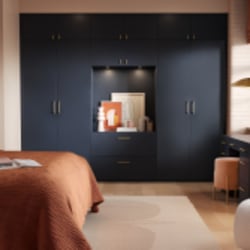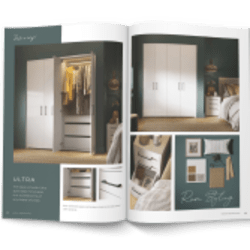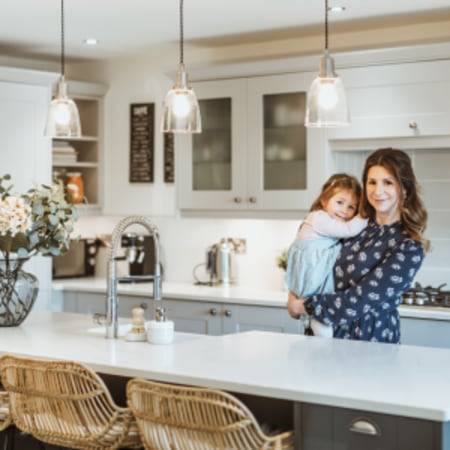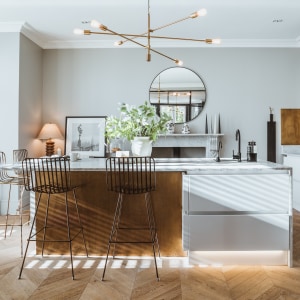Kitchen Hobs: Buying Guide
Kitchen Hobs
When building your ideal kitchen, most people tend to focus on the main appliances and fittings. Naturally, your choice of oven, the worktops, and model of fridge freezer are all very important elements that go into creating your cooking space, but for those who plan to cook plenty of large meals on a regular basis, your choice of gas or electric hob shouldn’t be overlooked.
Investing in one of the three types of hobs available is vital if you’re an avid chef. So many meals simply can’t be cooked inside an oven or microwave, and their flexibility makes cooking meals for big occasions simple and stress-free. But whether you choose an induction, gas, or electric hob, you want a model that can boil and simmer foods perfectly with an even heat distribution.
Of course, choosing from the different types of hobs available isn’t as simple as picking the first option you see. Kitchen style, size, and cooking necessity should all be considered before making your decision. That’s why we created this handy hob buying guide to explain all the ins and outs, enabling you to buy a hob you’re proud of.

Before you start
Like with many different appliances, there are a number of factors you need to take into account before picking from the different types of hobs available. For cooking hobs, the primary factors to consider are your kitchen size and the type of fuel you want to use with your hob.
Knowing the size of your kitchen and hob will help you understand where best to put it, and the different fuel options will determine heating speed and distribution. Once you have a good understanding of what these two elements include, you’ll find the buying process that much easier.
Size
One of the best things about all the different types of hobs currently available is that they almost all come in one specific range of sizes. The average hob width is typically between 50cm and 90cm, while almost all hobs are 50cm or less in-depth.
In general, your hob size will vary depending on the number of burners present on your particular model. The majority of hobs have 4 burners, though you can get smaller domino hobs with just two, and larger hobs with 5. The burners themselves are usually round in shape, though induction hobs specifically come with square rings that work with induction hob specific pans.
The number of burners or rings you want on your hob will determine the space you require, the average cost of the hob you choose, and how big an oven hood you’ll need to purchase in order to efficiently cover a hobs heat zone. This means you can’t just choose the largest hob available, especially if you don’t have a large kitchen.
For those who only have a small kitchen, it’s a much better idea to invest in a small hob with fewer burners, even if you do a lot of hob cooking. The additional space this leaves allows you to include other important cooking appliances like a microwave, or creature comforts such as a coffee machine. Buying a smaller hob will also substantially reduce the cost of your cooker hood by limiting your options to the smaller options available.
Alternatively, if you have a wide kitchen with an island, you can make your hob the kitchen’s centrepiece by placing it in the island’s middle, leaving space on the edge countertops for other kitchen preparation.
Fuel
The types of hobs available are all powered by two different types of fuel. Both are excellent options for cooking so your choice will likely come down to personal preference and cooking needs when deciding which hob type to buy. Gas hob options are the traditional choice for most kitchens. They’re brilliant at allowing you to find the precise heat for your pan and provide a good heat distribution. If you want a classic kitchen feel, this is the hob type you should buy. Electric hob options, on the other hand, heat much quicker, making them great for those who need to cook a quick meal before dashing out.
Types of hobs
Now it’s time to discuss the different types of hobs you can install in your kitchen. Choosing between an induction, gas, and electric model links back to your chosen fuel preference, especially if you want an induction model as these require electricity. There are many other benefits and drawbacks to the various types of hobs available besides the qualities associated with their fuel, all of which you should consider before buying to ensure you buy a hob that actually fits your kitchen.
Induction hobs
Once one of the most expensive types of hobs available, induction hobs have now been around long enough to become economically affordable for the average kitchen. Induction hobs work by using electricity to stimulate a magnetic field that links the induction element of the hob with the base of the pan, heating the pan rather than the hob itself. This allows the pan to be heated rapidly and efficiently with minimal heat loss from the hob.
Induction hobs come with plenty of useful features and are relatively easy to clean. However, they can make a series of strange noises as they work due to the induction coil and fan. On top of this, even though they’ve dropped in price, induction hobs are still rather expensive. Most induction hobs cost between an inexpensive £250 and a pricey £2,500. The price of an induction hob can also be increased if you need to buy induction friendly pots and pans, as standard pots and pans are not designed to be used with an induction hob. And if you have a pacemaker, you should look to invest in a different hob type as the magnetic field may interfere with your pacemaker’s function.
Electric hobs
Popular in small and contemporary kitchens, electric hobs are by far the cheapest hob option available, with good models costing £200 or less. Often made of ceramic glass, their smooth surface is easy to clean. if you want to buy an electric hob, it’s worth bearing in mind that they’re also very easy to use, being controlled by buttons on the hob itself for accurate temperature control. Some electric hobs even allow you to select how much of a large ring is heated, giving you two rings in one.
Electric hobs are not without their drawbacks, however. They’re slow to heat up and cool down, and their heat distribution can leave something to be desired when compared to a gas or induction hob. If you need simmer food, then they’re not the best option.
Gas hobs
Traditional hobs are almost exclusively gas hobs. Easy to control and provide immediate levels of heat, their even heat distribution capabilities make them ideal for simmering. Their all manual control knobs allow for very precise heat control and the automatic gas cut when the flame dies means you never have to worry about gas leaks.
That being said, they’re not as efficient as induction hobs, especially when heating up large pans; and while some models have an auto-ignition feature, many still require you to activate the gas and then press an ignition button, requiring two hands to use. They’re also the hardest hob type to keep clean due to their unnatural shape, possibly resulting in the ceramic glass that tops their burners being chipped or smashed if not handled carefully.
Gas hobs sit in the middle of the price bracket, costing as little as £100 or as much as £1,000, though purchasing a gas hob will likely cost more than the base price as you’ll need a qualified professional to fit it.
Hob materials
Much like hob type and fuel, your hob material of choice will likely come down to personal preference. You won’t have as much of a free hand as with the other two options, as certain hob materials are restricted to specific hob types, but you should have no trouble finding a material that fits your kitchen aesthetic.
Stainless steel
Stainless steel is a relatively modern material choice for kitchen hobs. Well suited to all styles, and looking great with most pan types, stainless steel is ideal if you have gas burners. Stainless steel is also naturally resistant to wear and tear and is very easy to clean, giving you a long-lasting and durable option.
Glass
More expensive than other hob materials, glass hobs provide a flat surface for you to place your pans on. This makes the hob very easy to clean thanks to its wipeable surface and glass properties, however, this is what increases the price.
Glass is most commonly used with electric and induction hobs; however, recent gas models have now been designed with glass surfaces in mind. A gas hob with glass material works by sitting the burners above the glass, allowing for a modern twist and a gas hob that’s easy to clean. Just be careful not to damage the glass with heavy impacts as it’s not as durable as other materials.
Ceramic
Ceramic is the typical hob material for electric hobs, providing a high-end finish for your hob. But while easy to clean and quick to heat, it can be difficult to control the heat level for precise cooking due to ceramics conductive qualities.
Hob features
Last but not least, you should consider what specialist features you want your hob to come with. All the types of hobs available will have different specialist features, so it’s up to you to decide which ones you think you’ll need in your kitchen.
Hot surface warning lights
Typically found on electric hobs, hob surface lights are a unique way of your hob letting you know how hot it is without having to go near the ring. The brighter the hob light, the hotter the hob, so you know when it’s blank that it’s safe to touch.
Electronic touch controls
Electronic touch controls are a great addition to electric and induction hobs, providing a simple and accurate way to choose your heat and then maintain or drop it when necessary. They’re easy to use but can be awkward to interact with if damp.
Pan presence sensors
Pan presence sensors are a great addition to any electric and induction hob. Sensors in the ring will respond to any pan being placed on it and heat the ring to the size of the pan. When the pan is removed, the ring will automatically switch off for safety and to save power.
Wok cooking zones
While many hobs can come with a bonus 5th ring, not all come with a wok specific cooking zone. These rings are large high-powered burners on gas hobs or dipped rings on an induction hob, that provide intense heat in order to cook stir-fry. If you like oriental food, this is the best type of hob accessory to buy.
Safety features
On top of the previously mentioned safety features, such as autogas cut off functions, pan sensors, and warning lights, many hobs come with child locks on their controls. This ensures they can’t be turned on accidentally by curious kids.
Where to buy a cooker hood
Here at Wren Kitchens, we stock a wide range of all types of cooker hobs, meaning you can buy a hob of your choosing that will fit seamlessly with your kitchen aesthetic. We also offer a variety of material finishes and a suite of varied colours to really narrow down your choice. By designing your kitchen with us, you can make that dream kitchen a reality.
Our experienced team of experts have decades of experience when it comes to creating peoples’ perfect kitchens. We’ll take you through the buying process step by step, from viewing to purchasing, taking into account all your requirements. Get in touch and book an appointment at your local showroom today to get started on building your ideal kitchen.
Feeling inspired? If you want to fit your kitchen out even further but want to do more research, you can find a range of kitchen and appliance buying guides right here. For other kitchen tips and tricks, you can read numerous articles in our inspiration section.













